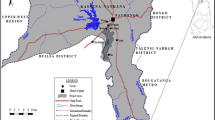Abstract
An investigation was conducted from 2001 to 2005 for determining the residual concentration of five pesticides, viz., total-HCH, total-DDT, total-Endosulfan, Dimethoate and Malathion in fish samples collected from various points of the river Ganga. Fish samples were analyzed for pesticide residues using standard laboratory procedures by GC method. It was found that total-HCH concentration remains above the MRL values for maximum number of times in comparison to four other pesticides. The pesticide contamination to fish may be due to indiscriminate discharge of polluted and untreated sewage-sludge to the river. The pesticide contents in some places are alarming. Thus proper care, maintenance, treatment and disposal of sewage water and sludge are most vital and should be the prime thrust for the nation.
Similar content being viewed by others
References
Adityachaudhury, N., Banerjee, H., & Kole, R. K. (1997). An appraisal of pesticides use in Indian agriculture with special reference to their consumption in West Bengal. Science and Culture, 63, 223–228.
Agnihotri, N. P., Gajbhiye, V. T., Mohapatra, S. P., Mukesh, K., & Kumar, M. (1994). Organochlorine insecticide residues in Ganga river water near Farrukhabad, India. Environmental Monitoring and Assessment, 30(2), 105–112. doi:10.1007/BF00545617.
Amorastt, M., Varothae, S., & Chunaoowatanakul, S. (1983). Determination of pesticides and some of the heavy metal residues in fish and water samples. Proc Fresh Water Fishes Epidemic 1982–1983 Research Affairs, (pp. 135–152). Chulalongkorn University, Bangkok (Thailand).
Badawy, M. I. (1998). Use and impact of pesticides in Egypt. International Journal of Environmental Health Research, 8, 223–229. doi:10.1080/09603129873507.
Bindra, O. S. (1972). Pesticidal pollution of water. Pesticides, 6, 77–82.
Brown, A. W. A. (1979). Ecology of pesticides (p. 174). New York: Wiley–Interscience Publication.
Chowdhury, A., Raha, P., Guha, P., Kole, R., Banerjee, H., & Das, M. K. (1994). Effect of pesticides on the ulcerative disease syndrome of fish- a case study. Pollution Research, 13, 161–167.
Eichelberger, J. W. & Lichtenberg, J. J. (1971). Persistence of pesticides in river water. Environmental Science & Technology, 5, 541–544. doi:10.1021/es60053a002.
FAO/WHO (1978). Acceptable daily intake, residue limits and guideline levels proposal at Joint Committee meeting, 23 pp.
Halder, P., Kole, R. K., Bhattacharya, A., Chowdhury, A., & Adityachaudhury, N. (1990). Studies on the residues of the BHC isomers (α, β, γ & δ) occurring in Ganga waters. Pollution Research, 9, 51–56.
Halder, P., Raha, P., Bhattacharyya, P., Chowdhury, A., & Adityachaudhury, N. (1989). Studies on the residues of DDT and Endosulfan occurring in Ganga water. Indian Journal of Environmental Health, 31, 156–161.
Honnen, W., Rath, K., Schlegel, T., Schwinger, A., & Frahne, D. (2001). Chemical analyses of water, sediment and biota in two small streams in southwest Germany. Journal of Aquatic Ecosystem Stress and Recovery, 8, 195–213. doi:10.1023/A:1012945427446.
Jinha, S., XimingLaZiyuan, C., & Detu, C. (1993). Behaviour of femprothion in rice/ fice/azolla ecosystem. J Zhejung Agri Univ (China), 19, 104–109.
Joshi, H. C. (1992). Environmental mediated stress on flood plain lakes. II- Pesticides and agricultural run-off. In Y. S. Yadav & V. V. Suguman (Eds.), Compendium of FAO sponsored foodplain fish mgmt. Central Inland Capture Fisheries Institute, Barrackpore.
Kathpal, T. S., & Dewan, R. S. (1975). An improved Cleanup technique for the estimation of residue of endosulfan and endrin. Journal—Association of Official Analytical Chemists, 58, 1076–1078.
Kole, R. K., & Bagchi, M. M. (1995). Pesticide residues in the aquatic environment and their possible ecological hazards. Journal of the Inland Fisheries Society of India, 27, 79–89.
Lambert, M. R. K. (1997). Environmental effects of heavy spillage from a destroyed pesticide store near Hargeisa (Somaliland) assessed during dry season, using reptiles and amphibians as bioindicators. Archives of Environmental Contamination and Toxicology, 32, 80–93. doi:10.1007/s002449900158.
Mohapatra, S. P., Gajbhiye, V. T., Agnihotri, N. P., Manju, R., & Raina, M. (1995). Insecticide pollution in Indian rivers. The Environmentalist, 15, 41–44. doi:10.1007/BF01888888.
Murty, A. S. (1986). Toxicity of pesticides to fish (vol. 1). Boca Raton, FL: CRC Press, Inc.
Rovedatti, M. G., Castane, P. M., Topalian, M. L., & Salibian, A. (2001). Monitoring of organochlorine and organophosphorus pesticides in water of the Reconquista River (Buenos Aires, Argentina). Water Research Oxford, 35, 3457–3461. doi:10.1016/S0043-1354(01)00058-6.
Schulz, R. (2001). Rainfall -induced sediment and pesticide input from orchards into the Lourens river, Western Cape, South Africa: Importance of a single event. Water Research, 35, 1869–1876. doi:10.1016/S0043-1354(00)00458-9.
Scott, G. I., Fulton, M. H., Moore, D. W., Wirth, E. F., Chandler, G. T., Key, P. B., et al. (1999). Assessment of risk reduction strategies for the management of agricultural nonpoint source pesticide runoff in estuarine ecosystem. Toxicology and Industrial Health, 15, 200–213. doi:10.1191/074823399678846673.
Trevisan, M., Montepiani, C., Ragozza, L., Bartoletti, C., Ioannilli, E., & Del Re, A. A. M. (1993). Pesticides in rainfall and air in Italy. Environmental Pollution, 80, 31–39. doi:10.1016/0269-7491(93)90006-A.
Tuncer, G., Karakas, T., Balkas, T. I., Gökcay, C. F., Aygnn, S., Yurteri, C., et al. (1998). Land-based sources of pollution along the Black Sea coast of Turkey: Concentrations and annual loads to the Black Sea. Marine Pollution Bulletin, 36, 409–423. doi:10.1016/S0025-326X(97)00205-1.
Vasu, K. (1996). Pollution of ground water and methods to minimise from environmental angle. In N. K. Roy (Ed.), Agrochemicals and sustainable agriculture (p. 238). New Delhi: APC Publications Pvt. Ltd.
Author information
Authors and Affiliations
Corresponding author
Rights and permissions
About this article
Cite this article
Aktar, M.W., Paramasivam, M., Sengupta, D. et al. Impact assessment of pesticide residues in fish of Ganga river around Kolkata in West Bengal. Environ Monit Assess 157, 97–104 (2009). https://doi.org/10.1007/s10661-008-0518-9
Received:
Accepted:
Published:
Issue Date:
DOI: https://doi.org/10.1007/s10661-008-0518-9




